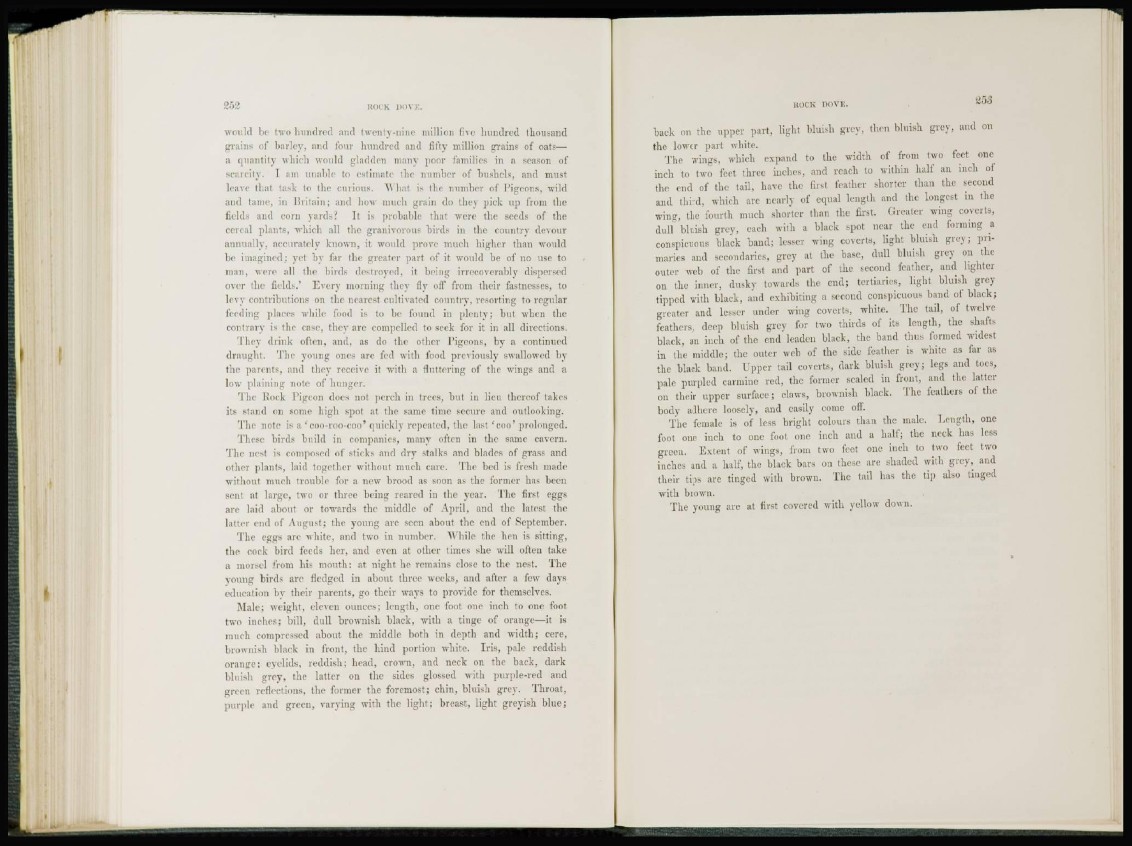
would be two hundred and twenty-nine million five hundred thousand
grains of barley, and four hundred and fifty million grains of oats—
a quantity wInch would gladden many poor families in a season of
scarcity. I am unable to estimate the number of bushels, and must
leave thai task to the curious. M hat is the number of Pigeons, wild
and tamo, in Britain; and how much grain do they pick up from the
fields and corn y a r d s I t is probable that were the seeds of the
cereal plants, which all the granivorous birds in the country devour
annually, accurately known, it would prove much higher than wotdd
be imagined; yet by far the greater part of it would be of no use to
man, were all the birds destroyed, it being irrecoverably dispersed
over the fields.' livery morning they fly off from their fastnesses, to
levy contributions on the nearest cultivated country, resorting to regular
feeding places while food is to be found in plenty; but when the
coi Mary is the case, they are compelled to seek for it in all directions.
They drink often, and. as do the other Pigeons, by a continued
draught. The young ones arc fed with food previously swallowed by
the parents, and they receive it with a fluttering of the wings and a
low plaining note of hunger.
The Rock Pigeon does not perch in trees, but in lieu thereof takes
its stand on some high spot at the same time secure and outlooking.
The note is a 'coo-roo-coo' quickly repeated, the last ' c o o ' prolonged.
These birds build in companies, many often in the same ea\ era.
The nest is composed of sticks and dry stalks and blades of grass and
other plants, laid together without much care. The bed is fresh made
without much trouble for a new brood as soon as the former has been
sent at large, two or three being reared in the year. The first eggs
are laid about or towards the middle of April, and the latest the
latter end of August; the young arc seen about the end of September.
The eggs arc white, and two in number. While the hen is sitting,
the cock bird feeds her, and even at other times she will often take
a morsel from his mouth: at night he remains close to the nest. The
voung birds arc fledged in about three weeks, and after a few days
education by their parents, go their ways to provide for themselves.
Male; weight, eleven ounces; length, one foot one inch to one foot
two inches; bill, dull brownish black, with a tinge of orange—it is
much compressed about the middle both in depth and width; cere,
brownish black in front, the hind portion white. Iris, pale reddish
orange; eyelids, reddish; head, crown, and neck on the back, dark
bluish grey, the latter on the sides glossed with purple-red and
green reflections, the former the foremost; chin, bluish grey. Throat,
purple and green, varying with the light; breast, light greyish blue;
back on the upper part, light bluish grey, then bluish grey, and on
the lower part white.
The wings, which expand to the width of from two feet one
inch to two feet three inches, and reach to within half an inch of
the end of the tail, have the first feather shorter than the second
and third, which arc nearly of equal length and the longest in the
wing, the fourth much shorter than the first. Greater wing coverts,
dull bluish grey, each with a black spot near the end forming a
conspicuous black band; lesser wing coverts, light bluish grey; primaries
and secondaries, grey at the base, dull bluish grey on the
outer web of the first and part of the second feather, and lighter
on the inner, dusky towards the end; tcrtiaries, light bluish grey
tipped with black, and exhibiting a second conspicuous band of black;
greater and lesser under wing coverts, white. The tail, of twelve
feathers, deep bluish grey for two thirds of its length, the shafts
black, an inch of the end leaden black, the band thus formed widest
in the middle; the outer web of the side feather is white as far as
the black band. Upper tail coverts, dark bluish grey; legs and toes,
pale purpled carmine red, the former scaled in front, and the latter
on their upper surface; claws, brownish black. The feathers of the
body adhere loosely, and easily come off.
The female is of less bright colours than the male. Length, one
foot one inch to one foot one inch and a half; the neck has less
green. Extent of wings, from two feet one inch to two feet two
inches and a half, the black bars on these are shaded with grey, and
their tips are tinged with brown. The tail has the tip also tinged
with brown.
The young are at first covered with yellow down.